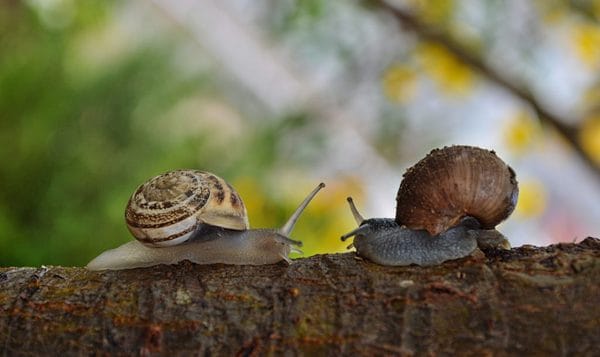If you want to get involved in Heliculture (snail production) and start your own business, you are at the right article. You will learn what are the advantages of this breeding system, and how to become a professional in this industry, which is in continuous growth.
You will find in this article the history of snail consumption, the most commonly marketed species, the main diseases, the advantage of owning a snail farm, and a famous production system that increases the volume of snails produced.

To know more about other types of snails such as the African Snail, check out Can people get sick from handling African snails? All you need to know about African snails and your health and Can African Snails be Pets? All You Need to Know About the Giant African Land Snail
and Can African Snails be Pets? All You Need to Know About the Giant African Land Snail
History
Because of their popularity, snails own a National Escargot Day in the United States on May 24th every year. People have been eating snails in the USA since the 1850s, but historically it is known that humans started eating snails in Spain, 3,3 million years ago, which means that snails have been part of human’s dishes since prehistoric times.
It is believed that the heliculture or snail production started around 10’000 years ago. Romans and several civilizations around the Mediterranean have left evidence of their snails consumption.
Why consider starting a snail farm
We find several escargot-based recipes in cooking books and on the web. It still remains an equilibrated food, because of its high countenance in protein, water and iron, and low content in fat. That’s why farmers and businessmen around the world have thought about having their own snail farm. It can be really lucrative, mostly depending on the snail variety. We can easily make 21$ per transformed kg, so 21’000 the tonne.
Types of snails
Several types of snails exist around the world. Some famous species which are used in snails farms and are very appreciated by snail’s consumers are:

- Helix aspersa or PETIT GRIS: It’s the most raised snail due to its ease of production and market acceptance. It is a little snail that is commercialized in adult age at a weight of approximately 7 gr.
- Achatina fulica or ESCARGOT CHINO : It is the biggest commercialized snail of the world. At adult age it raises 200gr. It is also known for its high reproduction capacity. This species may lay until 200 eggs while other species may lay 100 eggs. They tolerate hot climates.
- Helix aspersa maxima or GROS GRIS : These snails have an interesting reproduction capacity and they are very well accepted in the snails industry. They can reach 15g in their adult age. Temperate or cold climates are suitable for this snails type.
- Helix pomatia or SNAIL DE BOURGOGNE : It is the biggest snail type of Europe and it is very appreciated for its taste. Because of its Alps origin, it tolerates temperate and cold climates.
Feeding
Snails can be fed by natural methods. On one hand, we can use the natural method by giving them leaves and other greens, but you have to make sure to renew them every day in order to avoid moisture and diseases.
On the other hand, most experts advise feeding snails with dry powder. The main reason is that this product can be easily bought and it contains all the nutrients snails need: carbohydrates, protein, calcium, vitamins, and minerals which are essential for their good development. More information on feeding snails can be found online.
can be found online.
Furthermore, the feces will be dry and the mixed powder will not rot, which means that the environment will be widely more hygienic.
Dry food is really effective, it gives all the nutrients your snails need and it is really safe. You will find it in specialized stores or even in big pets stores.
With a little curiosity, you can even produce your own dry powder, which will remain less expensive, and you will choose personally which type, in which proportion, and of which quality are the ingredients you will put in. In any case, it is important to place the dry food in zones with no humidity and to control and respect the ingredient’s expiry dates.
Reproduction
In early spring females and male snails are put in a hot and humid space. The copulation will often occur during the night, and it can last between two and ten hours for each couple. As snails are hermaphrodites, twice will fecundate each other, and they will carry their own eggs.
They will lay eggs under the ground so that it has to be soft and wet. In order to ensure high humidity levels, some snails will cover the eggs with leaves and little branches. Eggs will hatch within more or less ten days, depending on the species and the environmental condition, and will often hatch on heavy rainy nights.
A special reproduction technique is the Combined breeding system which consists in forcing the reproduction season twice a year so that there will be more snails within less time. Instead of waiting in spring for snails to multiplicate themselves, you will be able to create the perfect environment a second time in winter.
For this method, we will use closed spaces where temperatures will be controlled and adapted. Humidity levels will also be crucial for the snail cycle. On the first time, we will force hibernal conditions by the end of the summer. Then, we will create optimal reproduction conditions during the winter, so that little snails will appear in early spring, which will give them more time to grow, this time, in an open pen. This means that we will be able to promote an entire annual cycle twice a year.
This method is used all around the world. Installations and maintenance are more expensive than traditional methods during the first year. However, it remains highly cost-effective over time.
Diseases and parasites
Snails can be attacked by several diseases and parasites. We can cite some as :
- Acarids or Riccardoella : It is a little and white parasite which sucks snail blood and weaks snails against other parasites or diseases. They are eliminated by using chemical products, or by introducing their natural predator in the snail farm.
- Batteries : We find them naturally in snails’ digestive systems. They only become a menace when there is a wrong proportion on the inside. It is usually due to sharp changes in humidity or temperature levels. The best way of preventing this disease is by ensuring a stable and well controlled environment.
- Helmintos : They are a second parasite species. They attack the snail’s reproductive system. Snails won’t be able to reproduce themselves, or, in advanced phases, they may die. There is no cure for this disease, but we will prevent it by giving to our snails clean water and food.
Pros of heliciculture
Snail consumption is very high all around the world. There exist several recipes which contain or whose main ingredient is escargots. Furthermore, in order to promote ecological animal-source protein, it is estimated that the demand in snails will increase by 500%. This offers an interesting estimation for those who want to initiate themselves in this industry.
is very high all around the world. There exist several recipes which contain or whose main ingredient is escargots. Furthermore, in order to promote ecological animal-source protein, it is estimated that the demand in snails will increase by 500%. This offers an interesting estimation for those who want to initiate themselves in this industry.
Conclusion
Snail production can be a successful business. Dedication and smart work can generate wonderful results. Because of the ecological way humans raise snails, the climate impact consciousness is being added to the traditional dishes, which represents old and new clients in this industry.

So in summary, we can observe the main pros of snail farming below :
- You can choose from a large variety of species by considering your project’s vision and your environment situation.
- Simplified feeding systems will allow your snails to grow healthy with a low risk of introducing diseases or parasites into your farm. It will also be more simpler for you to feed them and you will invest less time on it.
- Controlled reproduction methods will allow your snails to reproduce more efficiently and your snail production will be considerably increased.
- There exist few diseases or parasites which attack the snails, and they can be easily prevented.
- If you are new in heliciculture or you want to introduce yourself in it, we advise you to take some deep courses or ask experts for tips and accompaniment in your first steps.
It is extremely important to keep this advice in mind and to avoid failure, as explained in Why Did Snail Farming Fail In Asia? ,
,

